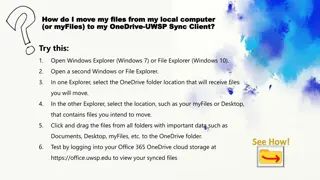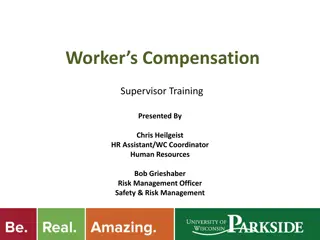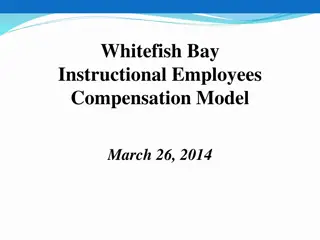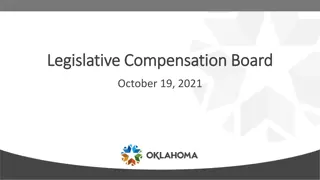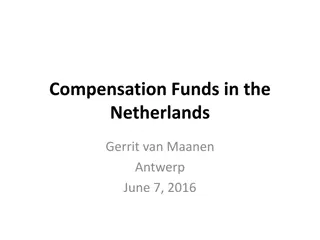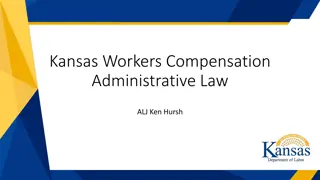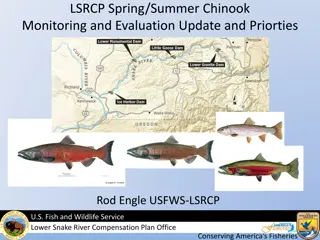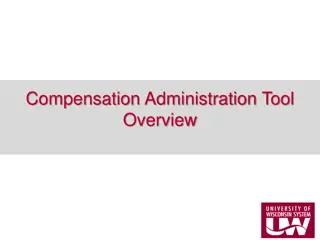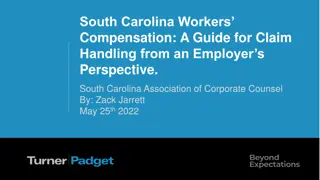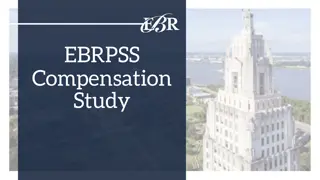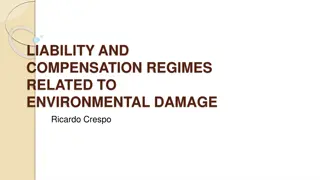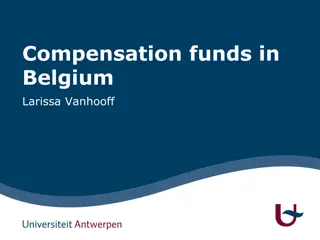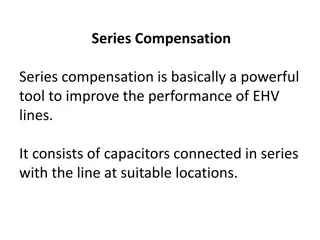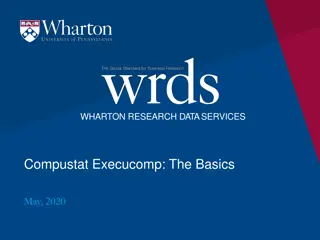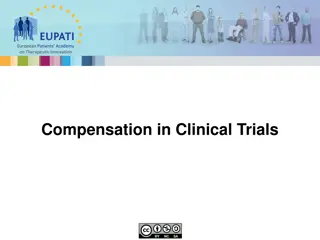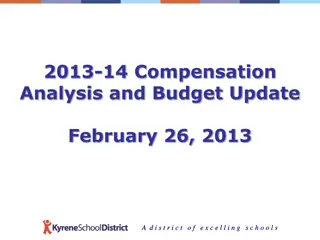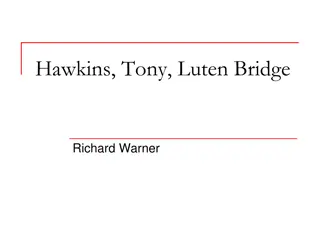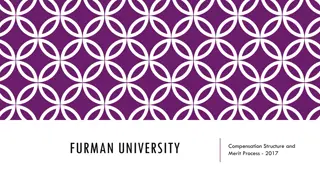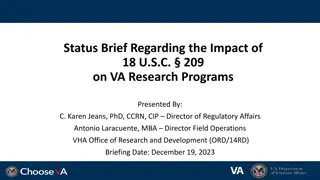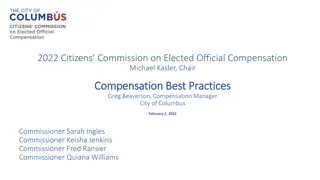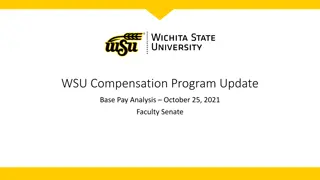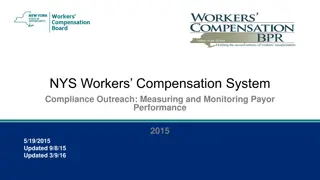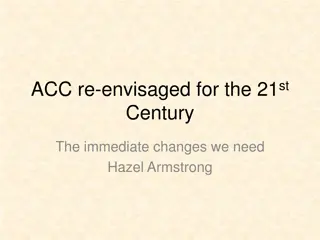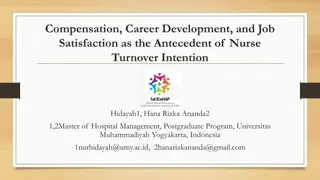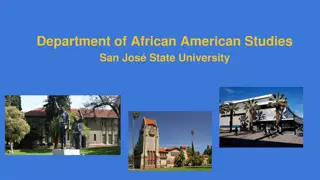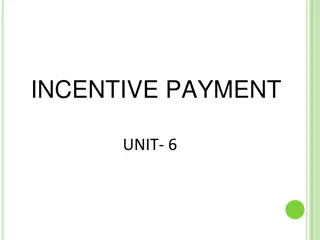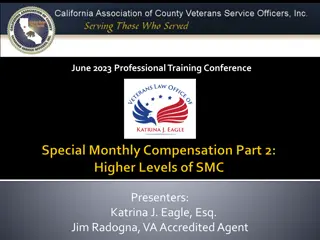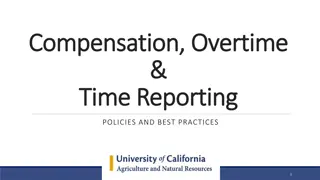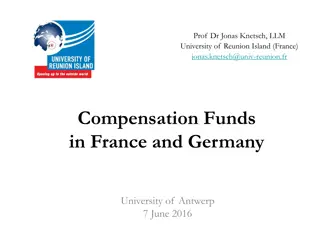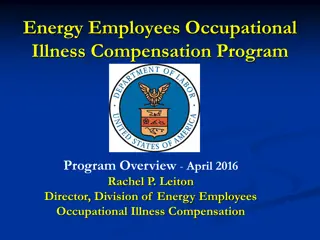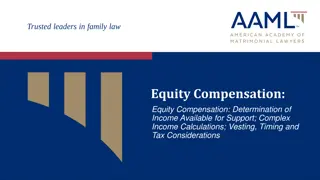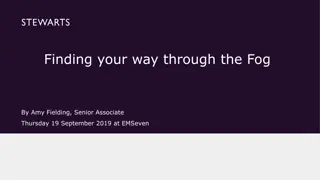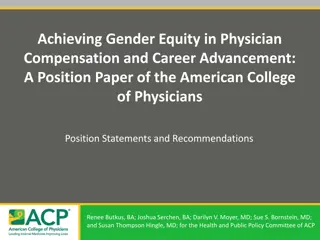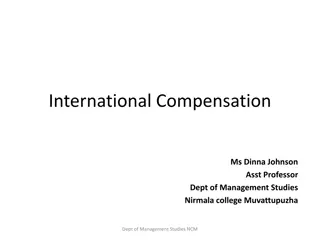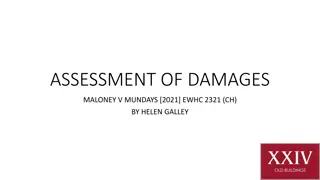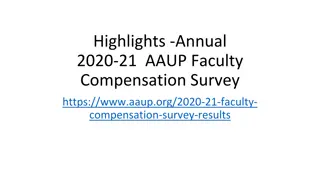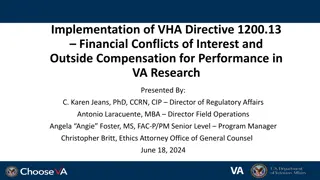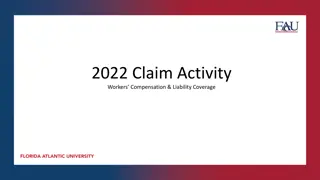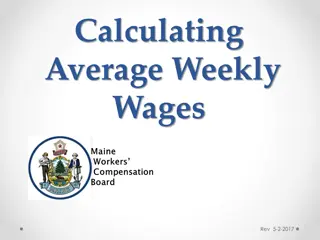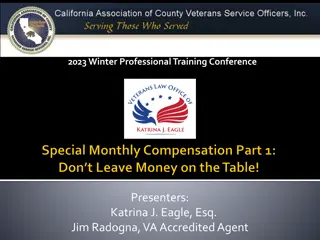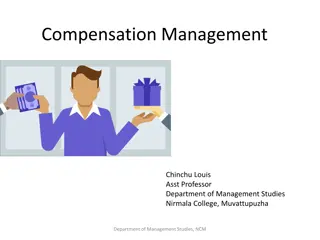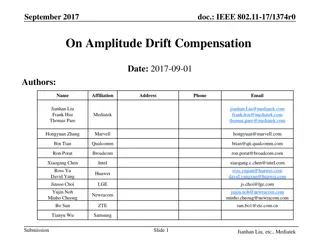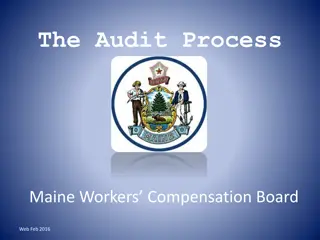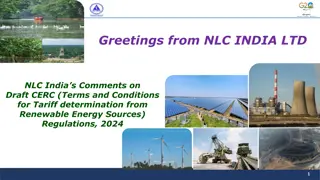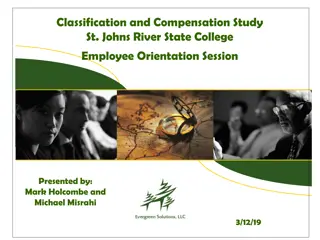UWSP Compensation Study Update: Goals, Current vs. Future State, and Major Components
In the September 2017 update for the UWSP compensation study, the forum aimed to provide details on the study's structure, timeline, and current phase. It highlighted the need to update job titles and functional groupings, align with current work trends, and establish clear career frameworks. Key components include market analysis, defining compensation philosophy, assessing positions, and developing new job structures. Stakeholder roles and responsibilities were also outlined, emphasizing effective governance and decision-making.
Download Presentation

Please find below an Image/Link to download the presentation.
The content on the website is provided AS IS for your information and personal use only. It may not be sold, licensed, or shared on other websites without obtaining consent from the author. Download presentation by click this link. If you encounter any issues during the download, it is possible that the publisher has removed the file from their server.
E N D
Presentation Transcript
Title and Total Compensation Study Update for UWSP September, 2017
Goals for Todays Forum Provide an overview of the structure of the study Provide an overview of the timeline of the study Provide detail of the current phase of the study 2
Current vs. Future State Current State Titles and functional groupings are outdated. Future State Titles and functional groupings reflect work performed today. Over 1,800 job titles exist. Some job titles have many incumbents performing very different work. Career frameworks are different across employee categories including career paths and requirements for progression that are not always clear. Job titles provide a basis for grouping positions performing similar work. Clearly defined career framework (spanning across all staff categories) providing helpful guidance to employees and managers. Market-informed salary structures in place for university staff, academic staff, limited appointee, and graduate student positions which help to attract and retain the best and brightest talent. Salary structures not based on relevant or updated market data. 6
Major Components of the Study Market analysis of compensation, benefits and work-life offerings Define and confirm compensation philosophy Assess positions and develop new job title structure Develop New Compensation Structure Implementation and Follow-up Reviews Develop Career Lattices 7
What the Study is NOT An equity study A reduction-in-force A pay plan 5
Stakeholder Groups Roles and Responsibilities Stakeholder Group Roles and Responsibilities Board of Regents Champion, oversight Executive Sponsors Champion, oversight, decision-maker Co-lead and ensure Advisory Council maintains focus on charge Communicate, endorse, advocate and monitor Communicate, lead and manage project work Communicate, support and provide feedback Communicate, educate, support, guide, perform administrative work at institution level Advisory Council Co-Chairs Advisory Council Project Leads/Project Team Shared Governance Groups HR Directors, staff and administrators Institution stakeholders Communicate, provide feedback
Governance & Decision Making Executive Sponsors Project Planning Team Advisory Council UW-MSN Project Leadership UWS Steering Committee Institution SMEs Institution Stakeholders Institution Project Teams SMEs Stakeholders Work Teams
Collaboration with Consultant (Mercer) and Stakeholders Leverage expertise and vendor experience with similarly situated systems and institutions Cost-effective and efficient use of resources Leverage talent and expertise of internal subject matter experts Emphasize communication, clarity and transparency Employ effective change management techniques 10
TTCS Phases II. Assess Positions and Modernize Job Title Structure IV. Review Benefits / Work-life and Leave Structures III. Create Compensation Structure (Spring 2018) V. Implement New Structures (Fall 2018- Spring 2019) I. Design and Study Strategy (Spring- Summer 2017) Review data Job framework Analysis of compensation Presentation to stakeholders Analysis of benefits and work/life and leave structures Develop project plan Map positions to the job/titling framework Salary structure Finalize program based on stakeholder feedback Stakeholder interviews and focus groups Gap analysis and recommend solutions Create/update job descriptions Preliminary cost analysis Finalize communication and change strategy Compensation philosophy guiding principles Preliminary communication and change mgmt strategy Stakeholder briefings Salary administration guidelines Deliver targeted communications Training for ongoing program administration FLSA Review Stakeholder briefings We are here! Parallel Process Nearing Completion
Mercer Resources Mercer Resources UW System UW System Project Structure Project Structure CHRO/HR Directors CHRO/HR Directors TTC Study TTC Study Subject Matter Subject Matter Workgroups Workgroups (Reports up to UW System) (Reports up to UW System) UW System Institution UW System Institution Project Teams Project Teams
Job Framework Components Career Paths Job Families and Sub-Families Levels Level Descriptors
Job Families/Sub-Families Job Family a group of jobs involving similar types of work and requiring similar training, skills, knowledge, and expertise. (Currently 22 Job Families Proposed) Sub-Family a sub-set of a job family that describes a specialized area.
T H E J O B F R A M E W O R K U T I L I Z I N G S U P P O R T S M U L T I P LE I M P O R T A NT A C T I V I T I E S Illustrative Job Descriptions/ Job Classifications Broadly describe the nature ofthe roles at UW Career Streams and Job Levels Describe incremental changes in job scope and responsibilities Recruiting/ Selection Performance Management Job Framework CAREER Path JOBLEVEL JOBFAMILY SUB-FAMILY Data and Digital Library Services Academic Services Manager Level Talent, Career,and Succession Planning Financial Compensation Management Organizational Contributor Collections and LibraryServices Level Administration HealthServices Human Resources Research, Outreach &Teaching Advancement Level Museum Collections& Exhibits Information Technology Arts Level Athletics/ RecreationalSports Museum Conservation Instruction Level Communications and Marketing Libraries and Museums Library and MuseumArchives Level Researchand Diagnostics Community & Public Education Level Research Administration Compliance,Legal &Protection Level Executive Leadership Sales and Hospitality Facilities and Capital Planning Student Services 1 6
J O B F R A M E W OR K 1 . J O B D E S IG N S T R U C T U RE E L E M E N TS F A M ILY Job families are groups of jobs involving work of the same nature and a similar skill set, and are distinct from departments. Examples of job families include Academic Services, Health Services, Finance, Human Resources, IT, Facilities, and Advancement Sub-families are more specific sub-sets within job families. Examples include Campus Police (within Compliance), and Alumni Relations (withinAdvancement) Joe Programmer works in theLibrary Sally Programmer works in the FinanceOffice Kelly Programmer works in the IT Department Joe, Sally and Kelly are all in the Information Technology job family despite working in different schools/departments at the institution
1 8 Job Framework Design Elements 2. Career Paths Illustrative Organizational Contributor Manager Mgr VIII OVERVIEW 2 career paths Mgr VII Provides distinction between Organizational Contributor and Manager tracks Mgr VI OCVIII Mgr V OC VII MgrIV 8 job levels per career path as starting point OC VI MgrIII OCV MgrII MgrI OCIV OCIII OCII OCI
Levels & Work Dimensions Level: Represents the hierarchical position of a job within a career path and is used to differentiate jobs based on predefined criteria Level Descriptors: Defines the characteristics of each level and articulates the increasing responsibilities and requirements of the job. Definitions for each level is consistent across job families Work Dimensions: Organizational Impact and Complexity, Leadership and Talent Management, Knowledge and Experience
Levels & Work Dimensions Current AS/LI Structure When we determine a level, these are the factors we review, currently and going forward: Education and Training = Knowledge and Experience Experience = Knowledge and Experience Complexity of work = Organizational Impact and Complexity Responsibility = Organizational Impact and Complexity Personal Interaction = Organizational Impact and Complexity Supervision = Leadership and Talent Management Working conditions = Organizational Impact and Complexity
JOB FRAMEWORK DESIGN E L E M E N T S J O B L E V EL DESCRIPTORS Illustrative First three levels of Organizational Contributor Job Level Descriptors Sample Level Descriptor Seasoned Contributor Organizational Impact and Complexity Independence / Supervision Works undergeneral supervision. Knowledge and Experience Post high schooldegree or trainingrequired; Bachelor's degree preferred. Overview Works undermoderate supervision. Work impacts teamand potentiallydepartments. Problems faced are variedbut generally within the scopeof the job s authority; policiesand practices guideresolution Executes day-to-day operationalplans. Participates in projects, programs, or systems needs. OC3 Works undermoderate supervision. Impact limited to own job or work unit. Works underclose supervisionfollowing specificinstruction. High school diplomaor equivalentrequired. Experienced Contributor Problems are typically routine but may at times require interpretation. Deviation from standard procedures requires supervisoryapproval. Issues are routine; solutions achieved through following established activities and processes. Relevant experience and/or basicknowledge of job-relatedstandards and processes preferred. OC2 Work is routine orfollows standardprocedures. Impact limited to own job or work unit. Works underclose supervisionfollowing specificinstruction. Generalwork experiencepreferred. Entry Contributor OC1 Work is closely supervised. Issues are routineand solutions are clearly prescribed. High school diplomaor equivalentrequired. Problems faced areroutine with clearly defined solutions.
Benefit Valuation Analysis (BVA) Total Compensation: [Direct] Pay + [Indirect] Benefits BVA defined: A customized benchmarking report that analyzes how benefit plans compare to a chosen peer group. Findings contain information on major employee benefit plan types including retirement/savings, health/group and time loss benefits.
For the BVA, Mercer will collect the following elements for the various employee groups:
Institution Project Teams Each UWS institution has put together a TTC Project Team to review and provide feedback on study methodologies, project outcomes, and feedback. The committee is also responsible for communication to their prospective institution, creating subject matter workgroups, and collecting and responding to questions and concerns. UW-Stevens Point TTC Project Team: Pam Dollard, Chief Human Resources and Affirmative Action Officer Katie Jore, Associate Vice Chancellor of Personnel, Budget, and Grants The following Human Resources and Affirmative Action members: Morgan Anderson Tom Bertram Anna Golackson Lisa Nelson Tina Rajski Lisa Schaufenbuel Colleen Sentkowski Jenny Resch Nanci Simon
Engagement Activities Institutions are required to report their activities monthly Monthly communique with Chancellors Weekly teleconferences with institution HR Directors Institution Title and Total Compensation Project Teams Institution communication plans being developed Website updates 2 6
Current Communication Steps - UWSP: Sept. 6, 2017 Common Council Update Sept. 7, 2017 University Staff Council Update Sept. 21, 2017 University Staff Council (further discussion) Sept. 22, 2017 Open Forum Sept. 26, 2017 Open Forum Oct. 2, 2017 Academic Staff Council Update
Pam Dollard Chief Human Resources and Affirmative Action Officer 715-346-3975 pdollard@uwsp.edu UWSP Project Website: http://www.uwsp.edu/hr/Pages/hraa/total-title-and- compensation.aspx UW System Project Website: https://www.wisconsin.edu/ohrwd/title-and-total- compensation-study THANK YOU!


